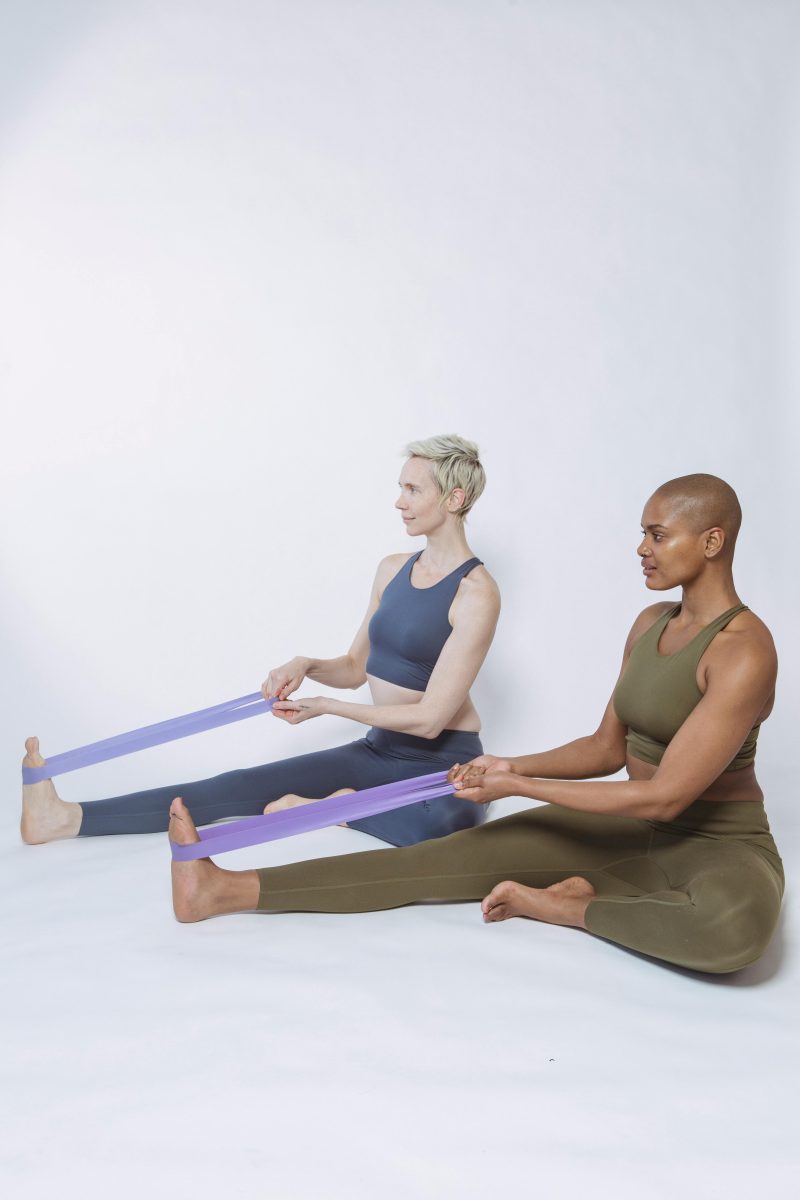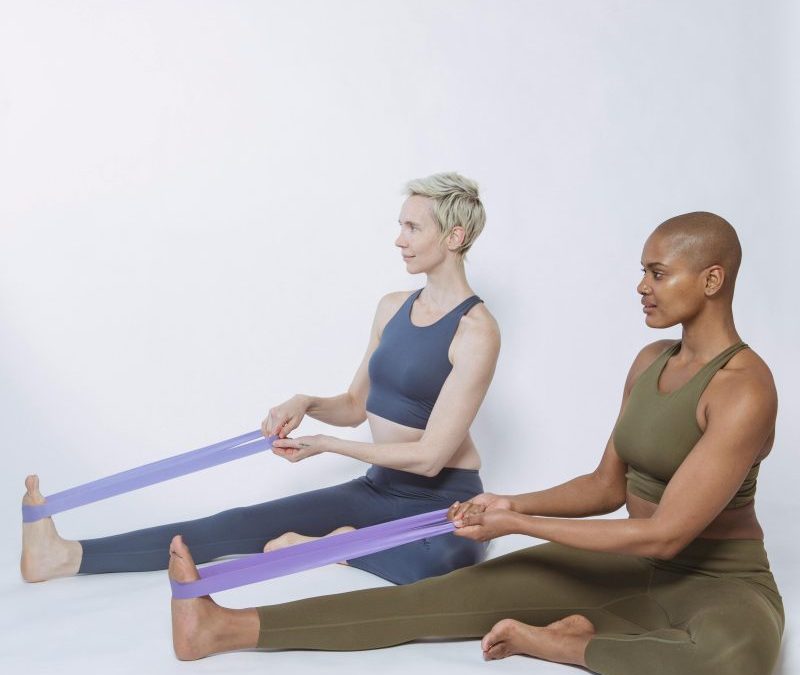Last Updated on: 14th July 2024, 09:32 am
Introduction to Resistance Band Workouts

Resistance bands are swiftly climbing the popularity charts in the fitness world. Their simplicity belies their effectiveness, making them a sought-after tool for those aiming to enhance their strength and flexibility. The beauty of resistance bands lies in their versatility. They cater to all fitness levels, from beginners to seasoned athletes, offering a wide range of exercises that can be modified to increase or decrease intensity.
- Build strength by providing resistance in both the concentric and eccentric part of an exercise.
- Improve flexibility and overall mobility, crucial for a well-rounded fitness regimen.
- Compact and portable, perfect for workouts at home, in the park, or while traveling.
Whether you’re looking to tone your body, build muscle, or enhance your flexibility, resistance band workouts can be tailored to meet your goals. Their adaptability makes them an invaluable tool for anyone looking to improve their physical health. Embrace the resistance band revolution and discover a more flexible, stronger you.
Understanding Resistance Bands

Different Types of Resistance Bands and Their Uses
- Loop bands: Ideal for lower body exercises, enhancing leg strength and agility.
- Tube bands with handles: Offer a gym-like experience, perfect for upper body workouts.
- Mini bands: Target the glutes and shoulders.
- Therapy bands: Aid in rehabilitation and flexibility exercises.
How Resistance Bands Work to Improve Strength and Flexibility
By adding resistance to movements, these bands challenge muscles in both the stretching and contracting phases, leading to increased strength and muscle tone. The constant tension from bands improves flexibility and range of motion, essential for a balanced fitness routine. This dual action makes resistance bands a powerhouse for enhancing physical health.
Tips for Selecting the Right Band for Your Fitness Level
- Start with a lighter resistance if you’re new, gradually moving to heavier bands as your strength improves.
- Consider the type of exercises you plan to do; some bands are better suited for certain movements.
- Always inspect bands for wear and tear to ensure safety.
Embracing resistance bands in your fitness journey opens up a world of possibilities. Their simplicity, combined with the profound impact they have on strength and flexibility, makes them an indispensable tool for anyone serious about their health. Let the versatility of resistance bands inspire you to explore new exercises and push your limits. The path to a stronger, more flexible you is laden with resistance, and that’s a good thing.
Maximizing Your Workout: Resistance Band Exercises for Strength and Flexibility

Building Upper Body Strength with Resistance Bands
- Bicep curls: Stand on the band and pull upwards with both hands.
- Tricep extensions: Secure the band behind you and extend your arms overhead.
- Lateral raises: Challenge your shoulders, enhancing your posture and strength.
Empowering Lower Body Workouts for Power and Endurance
- Squats: With a resistance band around your thighs to intensify the challenge.
- Lunges: Step into a lunge, and the resistance adds a new level of difficulty.
- Deadlifts: Stand on the band and lift with your legs, improving posture.
Core Strengthening Exercises for Stability and Balance
- Plank pull-aparts: Hold a plank while pulling a band apart with your hands.
- Russian twists: With a band increase resistance, sculpting your obliques.
- Leg raises: Band-assisted, challenge your lower abdominals.
Integrating resistance bands into your workout routine offers a path to remarkable strength and flexibility. With exercises tailored for the upper body, lower body, and core, you can achieve a balanced, powerful physique. The versatility and effectiveness of resistance bands make them an essential tool for anyone committed to their fitness journey. Embrace the challenge, and let the bands lead you to a stronger, more flexible you.
Enhancing Flexibility and Mobility with Resistance Bands

Stretching exercises with resistance bands are a game-changer for those looking to enhance their flexibility and mobility. By incorporating these bands into your stretching routine, you can create a controlled, intensified stretch that not only reaches but gently pushes your limits. This method allows for a deeper, more effective stretch, promoting increased flexibility over time.
- Dynamic stretches, characterized by their active movements, improve your range of motion.
- Regular flexibility training with resistance bands plays a pivotal role in injury prevention.
The integration of resistance bands into your flexibility and mobility training is not just beneficial; it’s transformative. These versatile tools offer a pathway to a more limber, resilient body, capable of withstanding the rigors of physical activity while minimizing the risk of injury. Embrace the resistance, and unlock a new level of physical freedom.
Designing Your Resistance Band Workout Routine

Creating a Balanced Workout Plan for Strength and Flexibility
Designing a workout routine with resistance bands that targets both strength and flexibility is key to a well-rounded fitness regimen. Start with exercises that engage major muscle groups for strength, such as squats and presses, and complement these with stretches and mobility exercises. This approach ensures your body remains not just strong but also supple.
Adjusting Intensity and Progression for Optimal Results
Adjusting the intensity of your resistance band workouts is crucial for continuous improvement. Begin with bands of lower resistance, focusing on mastering form and technique. As you progress, increase the resistance or the complexity of exercises to challenge your muscles further. This gradual progression fosters both strength gains and flexibility enhancements without risking injury.
Incorporating resistance band workouts into your existing fitness regimen can seamlessly elevate your physical capabilities. Start by replacing a few free-weight exercises with their band counterparts to understand the different muscle engagement bands offer. Gradually, integrate more band exercises, focusing on those areas needing improvement or variety. This method ensures a smooth transition and maximizes the benefits of your comprehensive fitness routine.
Remember, consistency is key. Regularly incorporating resistance band exercises into your routine not only diversifies your workouts but also leads to significant gains in strength and flexibility. Embrace the versatility and challenge of resistance bands, and watch as your body transforms into a stronger, more flexible version of itself.
Safety Tips and Best Practices

Proper Form and Technique to Avoid Injuries
- Mastering the correct form is crucial when using resistance bands. For instance, when performing a chest press, ensure your wrists remain straight and your movements controlled. This precision prevents undue stress on joints and maximizes muscle engagement.
- Similarly, during squats, keep your knees aligned with your toes and your back straight to avoid strain.
Understanding Your Body’s Limits and Signs of Overtraining
- Listen to your body’s cues. Sharp pain, excessive fatigue, and persistent soreness may signal overtraining.
- Rest is as important as the workout itself; it allows your muscles to recover and grow stronger. Incorporate rest days and vary your exercises to prevent overuse injuries and maintain a healthy training balance.
Maintenance and Care for Your Resistance Bands
- Resistance bands require simple yet essential care. Post-workout, wipe them down to remove sweat and oils. Store them away from direct sunlight, as UV rays can degrade the material.
- Regularly inspect for small tears or signs of wear that could lead to a band snapping during use, which can cause injury. With proper maintenance, your bands will remain a reliable workout partner.
Adhering to these safety tips and best practices ensures that your resistance band workouts are not only effective but also sustainable. By focusing on proper form, respecting your body’s limits, and caring for your equipment, you’ll pave the way for a safer and more rewarding fitness journey. Let these principles guide you as you stretch, strengthen, and sculpt your way to better health.
Real-Life Success Stories and Motivation

- Countless individuals have transformed their fitness journeys with the simple addition of resistance bands. From those struggling to find time for the gym to seasoned athletes seeking to enhance their performance, the stories of transformation are both inspiring and motivating.
- Richard Mac – previously hindered by joint pain, found that resistance bands offered a low-impact alternative to weights, leading to significant strength gains without the discomfort. “The problem with weights is the immediate, full resistance. With bands… it’s a gradual take-up so my muscles get the workout, but not my joints.
- Jasmine (Parent to a baby), utilized the portability of bands to maintain a consistent workout routine, achieving remarkable flexibility and muscle tone. “I struggled with achy joints after the birth of my first child. Pregnancy hormones had softened, already soft joints. I was never a big weight lifter, but even 5kg kettles were a problem. Exercise bands were my salvation. Various resistances sometimes doubled up. I had them all around the house to motivate me.
Resistance band workouts seamlessly complement other forms of exercise. Integrating bands into yoga practices, for example, can deepen stretches and increase flexibility. For weightlifters, bands add a challenging variation to traditional lifts, promoting muscle growth and endurance. This versatility ensures that no matter your fitness regimen, resistance bands can enhance your results.
- Starting and sticking with a resistance band routine requires motivation. Setting clear, achievable goals can serve as a powerful incentive. Celebrate each milestone, no matter how small, to maintain momentum.
- Remember, consistency is key. Even on days when motivation wanes, a quick resistance band workout can rekindle your commitment to fitness. Let the success stories of others inspire you to embark on your own journey, embracing the challenge and the promise of transformation that resistance bands offer.
Embrace the versatility and challenge of resistance bands, and watch as your body transforms into a stronger, more flexible version of itself. Let these real-life success stories be your guide and motivation as you embark on a journey of physical transformation. With resistance bands, the possibilities are endless, and the results are tangible. Start today, and join the ranks of those who have discovered the power of resistance band workouts.
In Closing
Resistance bands redefine fitness boundaries. They blend challenge with versatility, offering a unique path to strength and flexibility. Through a balanced mix of exercises, these bands cater to all, promising a journey filled with growth and resilience. Embrace the transformative power of resistance band workouts to sculpt a stronger, more flexible you. Let this be your call to action, a step towards a healthier, more empowered life.
Resistance Band Workouts for Strength and Flexibility FAQs
Resistance bands can be effective for weight loss as part of a comprehensive fitness routine. They help in building muscle, which in turn increases metabolism and burns more calories even at rest. Combining resistance band exercises with cardiovascular activities and a healthy diet can lead to effective weight loss.
Yes, resistance bands are incredibly versatile and can be used for both upper and lower body workouts. They can target all major muscle groups by adjusting the exercise, stance, and band tension. This versatility allows for a full-body workout with just one piece of equipment.
Yes, resistance band workouts can significantly improve flexibility. By using bands to create tension and stretch the muscles, you can enhance your range of motion over time. Incorporating dynamic stretches with bands before workouts and static stretches after can maximize flexibility gains.
Yes, resistance bands can build muscle similarly to weights. They provide resistance through the full range of motion, which is key for muscle growth. The versatility of bands allows for a wide variety of exercises targeting all major muscle groups.
Resistance bands are highly effective for injury rehabilitation. They allow for gentle strengthening of muscles without putting excessive strain on joints or the injured area. Working with a physical therapist to design a tailored resistance band program can ensure safe and effective rehabilitation.
Resistance bands are suitable for all fitness levels, from beginners to advanced athletes. They come in various resistance levels, which can be adjusted to match the user’s strength and fitness goals. This adaptability makes them an excellent tool for progressively increasing workout intensity.
Selecting the right resistance band depends on your current strength level and the exercises you plan to perform. Lighter bands are great for beginners or exercises that require a wider range of motion, while heavier bands are suited for stronger individuals or for exercises focusing on smaller, more specific muscle groups. It’s often beneficial to have a variety of bands to adjust the resistance as you progress.
For optimal results, aim to do resistance band workouts 2-3 times per week. This frequency allows for muscle recovery between sessions, which is crucial for muscle growth and strength gains. Varying the exercises and the resistance levels can help prevent plateaus and maintain progress.
Incorporating resistance band workouts into your fitness routine offers numerous benefits, including improved strength, flexibility, and muscle tone. They are portable and affordable, making them ideal for home workouts or for staying fit while traveling. Additionally, the variety of exercises you can perform with bands helps keep workouts interesting and challenging.
To maintain and store resistance bands, keep them away from direct sunlight, heat, and sharp objects. After use, clean them with a damp cloth to remove any sweat or dirt and dry them before storing. Hanging them or coiling them loosely in a cool, dry place can prevent damage and prolong their life.
Orlando is a all round athlete from Australia, now resident in Germany. His sports of passion of American Football(Offensive line), weight training and indoor rock climbing where he uses his 195cm wing span to his advantage.



